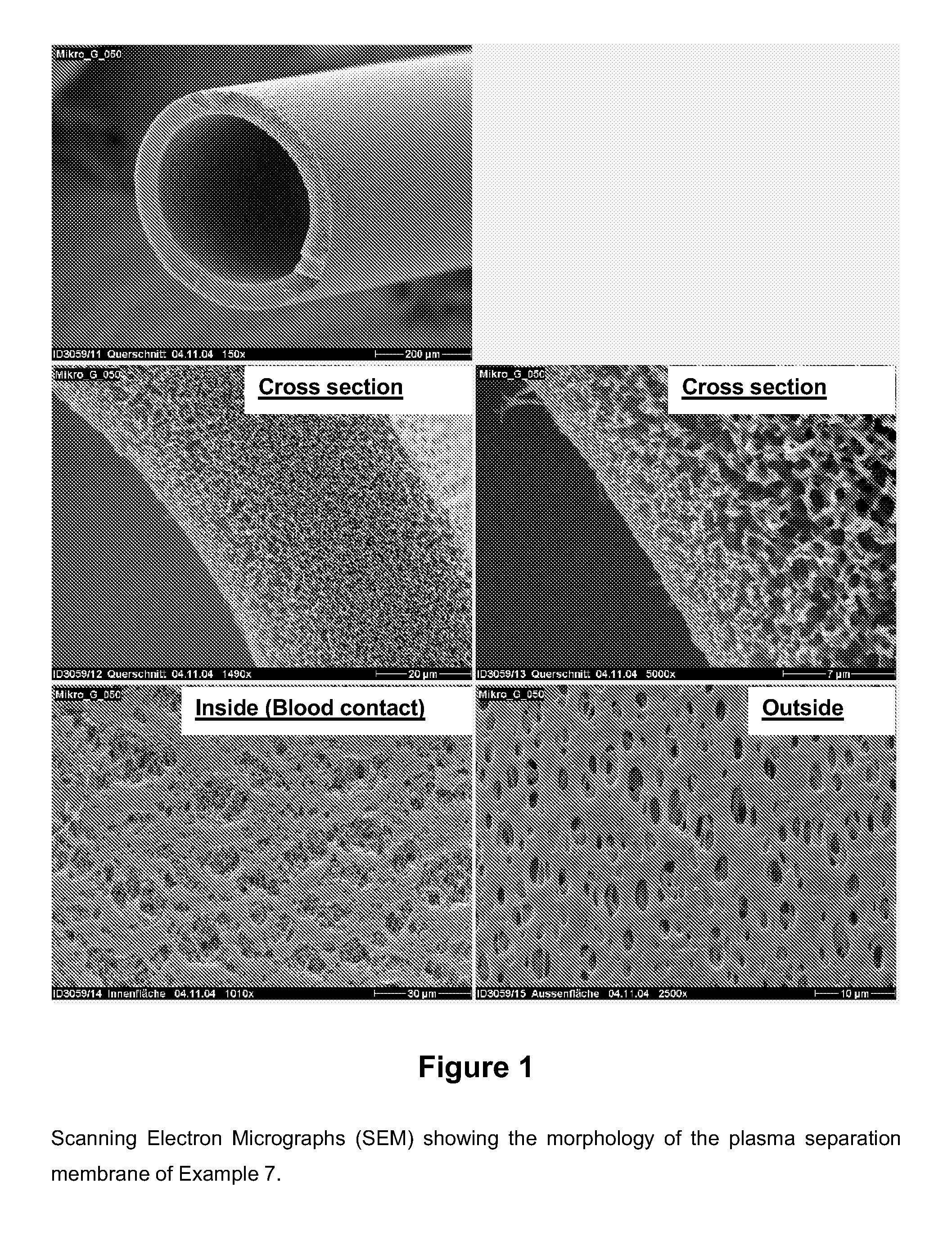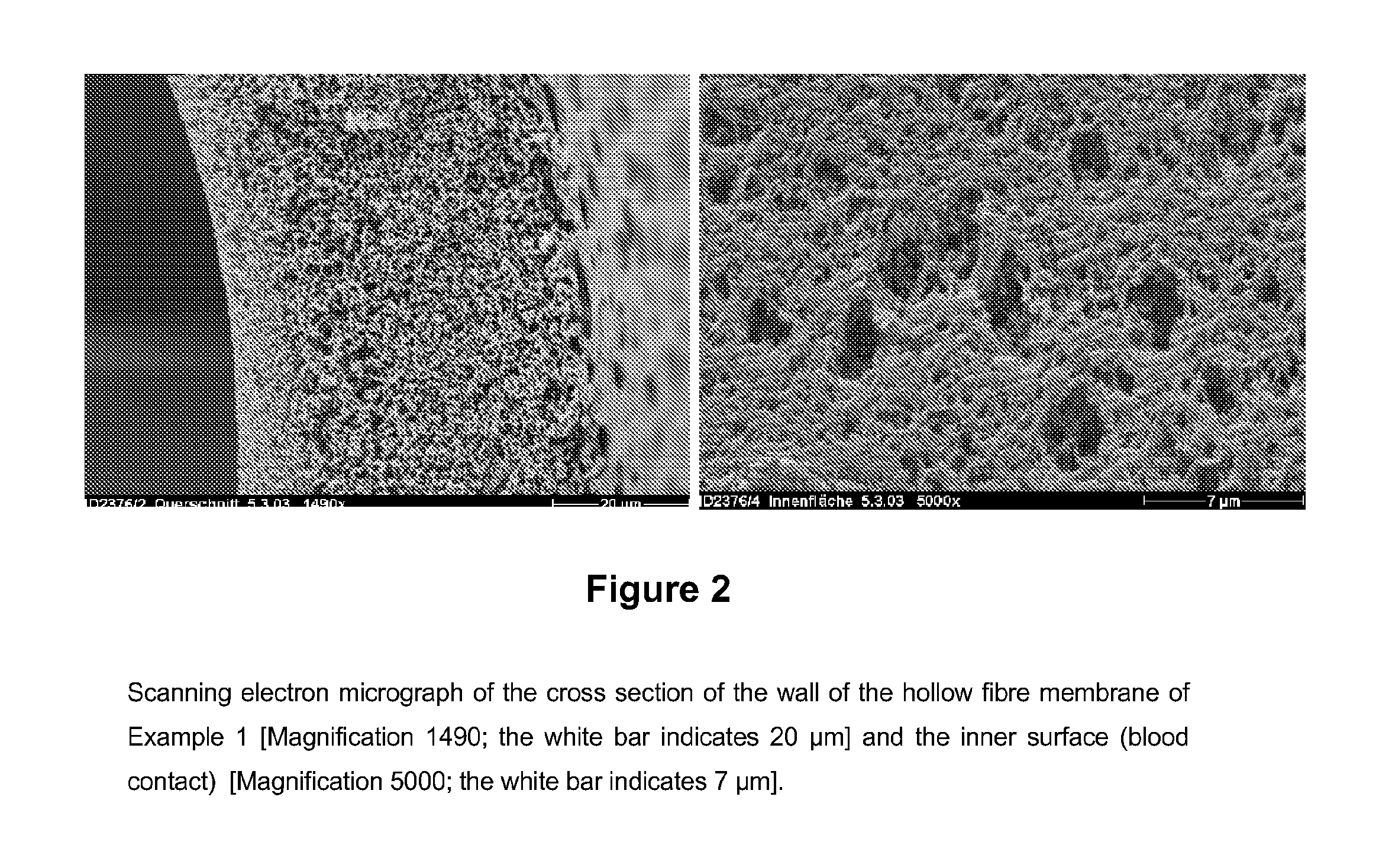Plasma Separation Membrane
- Summary
- Abstract
- Description
- Claims
- Application Information
AI Technical Summary
Benefits of technology
Problems solved by technology
Method used
Image
Examples
example 1
[0076]A polymer solution was prepared by dissolving 18.0 wt-% polyethersulfone (PES; BASF Ultrason 6020), 3.25 wt-% low molecular weight polyvinylpyrrolidone (PVP; BASF K30) and 8.0 wt-% high molecular weight polyvinylpyrrolidone (PVP; BASF K85 or K90) in 70.75 wt-% N-Methylpyrrolidone (NMP). The viscosity of the polymer solution at room temperature was 64250 mPa×s.
[0077]To prepare the solution, NMP was placed in a three neck-flask with finger-paddle agitator in the centre neck. Then, the PVP was added to the NMP and stirred at 50° C. until a homogeneous clear solution is formed. Finally, the polyethersulfone (PES) was added. The mixture was stirred at 50° C. until a clear high viscous solution is obtained. The warm solution was cooled down to 20° C. and degassed. To fully degas the solution the highly viscous polymer solution was transferred into a stable stainless steel container, the container was closed tightly and vacuum was applied to the container. The solution was degassed a...
example 2
[0081]In Example 2 the same compositions of the polymer solution and the centre fluid were used as in Example 1. The viscosity of the polymer solution at room temperature was 64250 mPa×s. The precipitation bath consisted of 82 wt-% NMP and 18 wt-% water. The membrane formation procedure was the same as in Example 1 with the exceptions that the distance between the die and the precipitation bath was 0.5 cm, and the spinning velocity was 10 m / min.
[0082]The resulting hollow fibre membrane had an inner diameter of 257 μm, an outer diameter of 337 μm and a fully asymmetric membrane structure. The total protein sieving coefficient was 97% at a transmembrane pressure (TMP) of 30 and 70 mmHg and 96% at a transmembrane pressure (TMP) of 110 mmHg (Mean Blood flow QB: 2.3 ml / min, mean shear rate: 190 1 / s). The degree of free haemoglobin as the corrected filtrate value was below the border of starting haemolysis of 0.2 for the tested values of 30, 70 and 110 mmHg.
example 3
[0083]In Example 3 the same compositions of the polymer solution and the centre fluid were used as in Example 1. The viscosity of the polymer solution at room temperature was 64250 mPa×s. The precipitation bath consisted of 82 wt-% NMP and 18 wt-% water. The membrane formation procedure was the same as in Example 1 with the exceptions that the distance between the die and the precipitation bath was 10 cm, and the spinning velocity was 10 m / min.
[0084]The resulting hollow fibre membrane had an inner diameter of 257 μm, an outer diameter of 335 μm and a fully asymmetric membrane structure. The total protein sieving coefficient was 98% at a transmembrane pressure (TMP) of 30 mmHg (Mean Blood flow QB: 2.5 ml / min, mean shear rate: 200 1 / s). The degree of free haemoglobin as the corrected filtrate value (compare description of the method) was below the border of starting haemolysis of 0.2 for the tested value of 30 mmHg.
PUM
| Property | Measurement | Unit |
|---|---|---|
| Temperature | aaaaa | aaaaa |
| Temperature | aaaaa | aaaaa |
| Pore size | aaaaa | aaaaa |
Abstract
Description
Claims
Application Information
 Login to View More
Login to View More - R&D
- Intellectual Property
- Life Sciences
- Materials
- Tech Scout
- Unparalleled Data Quality
- Higher Quality Content
- 60% Fewer Hallucinations
Browse by: Latest US Patents, China's latest patents, Technical Efficacy Thesaurus, Application Domain, Technology Topic, Popular Technical Reports.
© 2025 PatSnap. All rights reserved.Legal|Privacy policy|Modern Slavery Act Transparency Statement|Sitemap|About US| Contact US: help@patsnap.com



